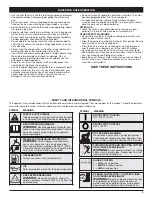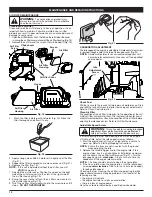
6
RECOMMENDED GASOLINE TYPE
Old gas is the primary reason for improper unit performance.
Be sure to use fresh, clean, unleaded gasoline.
NOTE:
This is a four cycle engine. In order to avoid damage to
the unit,
do not mix oil with gasoline
.
Definition of Blended Fuels
Today's fuels are often a blend of gasoline and oxygenates such
as ethanol, methanol or MTBE (ether). Alcohol-blended fuel
absorbs water. As little as 1% water in the fuel can make fuel
form acids when stored. When using alcohol-blended fuel, use
fresh fuel that is less than 60 days old.
Using Blended Fuels
If you choose to use a blended fuel, or if its use is unavoidable,
follow recommended precautions:
• Always use fresh unleaded gasoline
• Use Sta-Bil® or an equivalent
• Drain tank and run the engine dry before storing unit
Using Fuel Additives
The use of fuel additives, such as Sta-Bil® or an equivalent, will
inhibit corrosion and minimize the formation of gum deposits.
Using a fuel additive can keep fuel from forming harmful deposits
in the carburetor for up to six (6) months. Add 0.8 oz. (23 ml.) of
fuel additive per gallon of fuel to an approved gas container
according to the instructions on the container. NEVER add fuel
additives directly to the unit's gas tank.
FUELING THE UNIT
1.
Remove fuel cap. Remove the tag from the fuel tank neck.
NOTE:
Fill or add gas to the tank only when the cultivator is in
a horizontal position (Fig. 9).
2.
Place spout of gas container into the fill hole on the gas
tank and fill tank.
NOTE:
Do not overfill tank.
3.
Wipe up any gasoline that may have spilled.
4.
Reinstall the gas cap.
5.
Move the unit at least 30 ft. (9.1 m) from the fueling source
and site before starting the engine.
NOTE:
Dispose of the old gasoline in accordance to Federal,
State and Local regulations.
Fig. 9
Gas Cap
OIL AND GAS INFORMATION
3.
Remove the oil plug / dipstick from the crankcase (Fig. 7).
4.
Pour the entire bottle of oil into the oil fill hole (Fig. 8).
NOTE:
Never add oil to the gas or gas tank.
5.
Wipe up any oil that may have spilled and reinstall the oil fill
plug / dipstick.
The importance of checking and maintaining the proper oil level
in the crankcase cannot be overemphasized. Check oil before
each use and change as specified in the Maintenance Schedule.
Fig. 7
Oil Fill Plug/
Dipstick
Oil Fill Hole
O-Ring
Fig. 8
Oil Fill
WARNING:
Remove gas cap slowly to avoid
injury from fuel spray. Never operate the unit without
the fuel cap securely in place.
WARNING:
Add fuel in a clean, well ventilated
outdoor area. Wipe up any spilled gas immediately.
Avoid creating a source of ignition for spilt fuel. Do
not start the engine until fuel vapors dissipate.
RECOMMENDED OIL TYPE
Using the proper type and weight of oil in the crankcase is
extremely important. Check the oil before each use and
change the oil regularly. Using incorrect or dirty oil can cause
premature engine wear and failure.
Use a high-quality SAE 30 weight oil of API (American
Petroleum Institute) service class SF, SG, SH.
ADDING OIL TO CRANKCASE: INITIAL USE
NOTE:
This unit is shipped without oil in
the crankcase. In order to avoid
damage to the unit, put oil in the
crankcase before attempting to
start unit.
Your unit is supplied with one 3.04 fluid
oz. (90 ml) bottle of SAE 30 SF, SG, SH
oil (Fig. 5).
NOTE:
Save the bottle to measure the
correct amount for future oil
changes. See
Changing the Oil
.
NOTE:
Your new 4-Cycle cultivator is
shipped for operation in
conditions above 40°F (4°C). For cold weather
operation, where temperatures fall below 40°F (4°C),
use a high-quality SAE 10W30 weight oil of API
(American Petroleum Institute) service class SF, SG, SH.
1.
Unscrew the oil bottle top and remove the paper seal
covering the opening. Replace the top and cut the tip off
the funnel spout (Fig. 5).
2.
Place the unit on a flat level surface with the cultivator in a
horizontal position (Fig. 6).
Fig. 5
Fig. 6
Oil Fill
Plug/Dipstick
CAUTION:
OVERFILLING OIL CRANKCASE MAY
CAUSE PRODUCT DAMAGE. Check and maintain the
proper oil level in the crank case; it is important and
cannot be overemphasized. Check the oil before each
use and change it as needed. See
Changing the Oil.







































